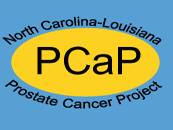Tumor Block Retrieval and Tissue Microrarray (TMA) Construction
Tumor block retrieval is summarized in Table 1. In nearly all state-race groups, 100% of subjects who completed a study visit also consented to release diagnostic tissue. The exceptions are 99.8% of post-Katrina LA AA (505of 508) and 99.4% of NC AA (502 of 505). Paraffin blocks containing diagnostic prostate tissue biopsies (core biopsies or TURP samples used to diagnose cancer) were requested from hospitals or reference pathology laboratories. A few facilities provided unstained slides instead of tissue blocks. Hospitals/labs declined to release diagnostic tissue for 96 or 9.3% of NC cases (56 or 11.2% AA, 40 or 7.6% CA), 44 or 20.7% of pre-Katrina cases (32 or 26.9% AA, 12 or 12.8% CA) and 96 or 9.5% post-Katrina LA cases (81 or 16.0% AA, 15 or 3.0% CA). Reasons for decline included overall policy (i.e., no blocks are ever released from that facility)or case-specific reasons (e.g., a particular patient’s blocks did not contain enough tissue).
Diagnostic tissue (blocks or slides) was received for 879 NC subjects or 85.3% of NC subjects who completed a visit (412 or 81.6% AA; 467 or 88.8% CA); 113 or 53.1% of pre-Katrina subjects (53 or 44.5% AA, 60 or 63.8% CA); and 775 or 76.4% of post-Katrina subjects (363 or 71.7% AA, 412 or 81.1% CA).
For each subject, six sections were cut from each representative positive diagnostic block and one from each negative (without adenocarcinoma) block. Of the six sections from each positive diagnostic block; one was stained for eosin and hematoxylin and reviewed by the study pathologist in order to identify areas of cancer. One additional positive section/slide was immuno-stained for Ki-67 and caspase-3 and analyzed using automated image analysis. The remaining sections were archived. See Table 2 for additional detail.
In NC, 638 subjects (289 AA, 349 CA) indicated at the time of the study visit that they chose radical prostatectomy (RP) for their method of prostate cancer treatment. In pre-Katrina LA, 99 subjects (58 AA, 41 CA) chose RP, while in post-Katrina LA 509 subjects (230 AA, 279 CA) chose RP. This equates to 61.9% of NC subjects who completed a study visit (57.2% AA, 66.3% CA), 46.5% of pre-Katrina subjects (48.7% AA, 43.6% CA) and 50.2% of post-Katrina subjects (45.5% AA, 54.9% CA). Of those subjects who chose RP, consent to release that tissue to PCaP was provided by 593 or 92.9% of NC subjects (260 or 90.0% AA, 333 or 95.4% CA), 50 or 50.5% of pre-Katrina subjects (23 or 39.7% AA, 27 or 65.9% CA),and 506 or 99.4% of post-Katrina subjects (228 or 99.1% AA, 278 or 99.6% CA). Some NC subjects and all pre-Katrina LA subjects were contacted after the study visit to ask for release of RP tissue, with many pre-Katrina LA subjects lost to contact after Hurricane Katrina; thus, their rates are lower than those for post-Katrina LA, all of whom were asked for release of RP tissue at the time of their study visit.
Paraffin-embedded prostatectomy specimens were requested for consenting participants who had undergone or scheduled an RP at the time of the study visit. A few facilities provided unstained slides instead of tissue blocks. Hospitals/labs declined to release RP tissue for 68 or 11.5% NC subjects (23 or 8.8% AA, 45 or13.5 % CA), 7 or 14.0% pre-Katrina (3 or 13.0% AA, 4 or 14.8% CA) and 38 or 7.5% post-Katrina LA subjects (13 or 5.7% AA, 25 or 9.0% CA). Reasons for decline included overall policy (i.e., no blocks were ever released from that facility) or case-specific reasons (e.g., a particular patient’s blocks did not contain enough tissue).
RP tissue was received for 442 NC subjects or 42.9% of NC subjects who completed a visit (196 or 38.8% AA, 246 or 46.8% CA); 19 or 8.9% of pre-Katrina subjects (9 or 7.6% AA, 10 or 10.6% CA); and 331 or 32.6% of post-Katrina subjects (169 or 33.4% AA, 162 or 31.9% CA). When considering only those subjects who indicated at the study visit that they chose CaP treatment via RP, rates of RP tissue receipt are 69.3% for NC (67.8% AA, 70.5% CA), 19.2% for pre-Katrina LA (15.5% AA, 24.4% CA) and 65.0% for post-Katrina LA (73.5% AA, 58.1% CA).
Similar to the process for sectioning diagnostic specimens, 6 slides were cut from each positive RP block and 1 from each negative (without adenocarcinoma) RP block. One newly-cut section from the surgical specimen was reviewed by the study pathologist to select areas of cancer for construction of tissue microarrays (TMAs), and additional sections were archived (see Table 2 for additional detail). TMAs were constructed with 0.6 mm core punches of neoplastic tissue and one core of paired non-neoplastic tissue from the same subject using the following algorithm:
| Number of blocks containing cancer | Number of cancer cores | Benign core |
|---|---|---|
| ≥6 | 12 | 1 |
| 5 | 10 | 1 |
| 4 | 8 | 1 |
| 3 | 9 | 1 |
| 2 | 8 | 1 |
| 1 | 5 | 1 |
The following information was recorded for each core inserted:
- Research subject study ID number;
- Research Block number;
- Punch identifier;
- Benign or cancer (Gleason primary and secondary grades) coded centrally by a study reference pathologist;
- Percent prostatectomy specimen involved by tumor coded centrally by a study reference pathologist;
- TMA block number (for radical prostatectomy TMAs);
- TMA location (x, y-coordinates)(for radical prostatectomy TMAs).
The number of sections and cores cut from each block was reduced when necessary to ensure that diagnostically important tissue was not depleted. Blocks were returned within four months (or immediately on request).




